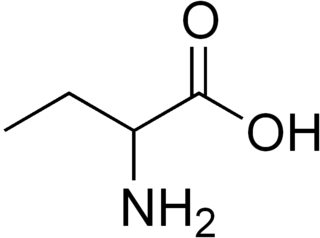This page is based on this
Wikipedia article Text is available under the
CC BY-SA 4.0 license; additional terms may apply.
Images, videos and audio are available under their respective licenses.

The GABA receptors are a class of receptors that respond to the neurotransmitter gamma-aminobutyric acid (GABA), the chief inhibitory compound in the mature vertebrate central nervous system. There are two classes of GABA receptors: GABAA and GABAB. GABAA receptors are ligand-gated ion channels ; whereas GABAB receptors are G protein-coupled receptors, also called metabotropic receptors.

Chloralose is an avicide, and a rodenticide used to kill mice in temperatures below 15 °C. It is also widely used in neuroscience and veterinary medicine as an anesthetic and sedative.

Enflurane is a halogenated ether. Developed by Ross Terrell in 1963, it was first used clinically in 1966. It was increasingly used for inhalational anesthesia during the 1970s and 1980s but is no longer in common use.
GABAB receptors (GABABR) are metabotropic transmembrane receptors for gamma-aminobutyric acid (GABA) that are linked via G-proteins to potassium channels. The changing potassium concentrations hyperpolarize the cell at the end of an action potential. The reversal potential of the GABAB-mediated IPSP is –100 mV, which is much more hyperpolarized than the GABAA IPSP. GABAB receptors are found in the central nervous system and the autonomic division of the peripheral nervous system.

Progabide (INN) is an analogue and prodrug of γ-aminobutyric acid (GABA) used in the treatment of epilepsy. Via conversion into GABA, progabide behaves as an agonist of the GABAA, GABAB, and GABAA-ρ receptors.

γ-Amino-β-hydroxybutyric acid (GABOB), also known as β-hydroxy-γ-aminobutyric acid (β-hydroxy-GABA), and sold under the brand name Gamibetal among others, is an anticonvulsant which is used for the treatment of epilepsy in Europe, Japan, and Mexico. It is a GABA analogue, or an analogue of the neurotransmitter γ-aminobutyric acid (GABA), and has been found to be an endogenous metabolite of GABA.

Gamma-aminobutyric acid (GABA) B receptor, 1 (GABAB1), is a G-protein coupled receptor subunit encoded by the GABBR1 gene.

Gamma-aminobutyric acid receptor subunit beta-1 is a protein that in humans is encoded by the GABRB1 gene.

GABA transporter 1 (GAT1) also known as sodium- and chloride-dependent GABA transporter 1 is a protein that in humans is encoded by the SLC6A1 gene.

Gamma-aminobutyric acid receptor subunit rho-1 is a protein that in humans is encoded by the GABRR1 gene.

Gamma-aminobutyric acid receptor subunit pi is a protein that in humans is encoded by the GABRP gene.

Hopantenic acid, also known as N-pantoyl-GABA, is a central nervous system depressant. Formulated as the calcium salt, it is used as a pharmaceutical drug in the Russian Federation for a variety of neurological, psychological and psychiatric conditions and sold as Pantogam. It is not approved for use in Europe or the United States.

Ethanolamine-O-sulfate (EOS) is an ester of sulfuric acid and ethanolamine. EOS is a GABA transaminase inhibitor which prevents the metabolism of GABA. It is used as a biochemical tool in studies involving GABA.

Pivagabine, also known as N-pivaloyl-γ-aminobutyric acid or N-pivaloyl-GABA, is an antidepressant and anxiolytic drug which was introduced in Italy in 1997 for the treatment of depressive and maladaptive syndromes. But it was discontinued in Italy. Originally believed to function as a prodrug to GABA, pivagabine is now believed to act somehow via modulation of corticotropin-releasing factor (CRF).

Quisqualamine is the α-decarboxylated analogue of quisqualic acid, as well as a relative of the neurotransmitters glutamate and γ-aminobutyric acid (GABA). α-Decarboxylation of excitatory amino acids can produce derivatives with inhibitory effects. Indeed, unlike quisqualic acid, quisqualamine has central depressant and neuroprotective properties and appears to act predominantly as an agonist of the GABAA receptor and also to a lesser extent as an agonist of the glycine receptor, due to the facts that its actions are inhibited in vitro by GABAA antagonists like bicuculline and picrotoxin and by the glycine antagonist strychnine, respectively. Mg2+ and DL-AP5, NMDA receptor blockers, CNQX, an antagonist of both the AMPA and kainate receptors, and 2-hydroxysaclofen, a GABAB receptor antagonist, do not affect quisqualamine's actions in vitro, suggesting that it does not directly affect the ionotropic glutamate receptors or the GABAB receptor in any way. Whether it binds to and acts upon any of the metabotropic glutamate receptors like its analogue quisqualic acid however is unclear.
4-aminobutyrate---pyruvate transaminase is an enzyme with systematic name 4-aminobutanoate:pyruvate aminotransferase. This enzyme is a type of GABA transaminase, which degrades the neurotransmitter GABA. The enzyme catalyses the following chemical reaction

Tolibut, also known as 3-(p-tolyl)-4-aminobutyric acid, is drug that was developed in Russia. It is an analogue of γ-aminobutyric acid (GABA) and is the 4-methyl analogue of phenibut, and is also an analogue of baclofen where the 4-chloro substitution has been replaced with a 4-methyl substition. Tolibut has been described as possessing analgesic, tranquilizing, and neuroprotective properties. It is not fully clear as to whether the drug was ever approved or used medically in Russia, though it may have been. Tolibut probably acts as a GABAB receptor agonist similarly to phenibut and baclofen.

















